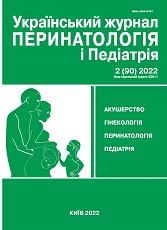Tetrallogy of Fallot and hypertrophic cardiomyopathy. Unusual association
DOI:
https://doi.org/10.15574/PP.2022.90.59Keywords:
Tetrallogy of Fallot, hypertrophic cardiomyopathy, cyanotic spell, echocardiography, childrenAbstract
Tetrallogy of Fallot (ToF) is the most widespread congenital heart defect characterized by a wide anatomic spectrum and clinical manifestations, which depend on the degree of stenosis of the pulmonary artery, and can be associated with chromosomal abnormalities.
Hypertrophic cardiomyopathy (HCM) is a rare genetic disorder that often occurs in the autosomal-dominant type and has a high risk of cardiac death and is associated with abnormalities in certain gene loci.
Clinical case. We present this rare association in a 9-month-old girl, without previous history of heart defect, who was admitted to intensive care unit with a clinical presentation of severe hypoxic spell.
A rare case of the combination of ToF and HCM has been reported in a 9-month-old child admitted to the reanimation department of the Lviv Regional Children’s Clinical Hospital «OKHMATDYT» for malignant and cyanotic attacks.
The girl was hospitalized for reanimation in a jaundice-cyanotic crisis with a saturation rate of 44%. On examination, a pronounced sciatica, pallor and cyanosis of the lips were detected. Auscultatively, the heart tones were rhythmic, muffled, the heart rate - 202 beats per second, systolic murmur was detected on the left side of the chest 5/6 on the Levine scale. Electrocardiogram showed signs of systolic hypertension and hypertrophy of the right ventricle. 2D-echocardiographic examination revealed hypertrophy of the left and right ventricular walls and interventricular septum as well as signs of ToF. On the magnetic resonance imaging the diagnosis was confirmed. After the stabilization of the general condition the child was transported to the Center of Pediatric Cardiology and Cardiac Surgery in Kyiv for surgical treatment, where it was recommended to continue the medical treatment with beta-blockers. After 2 months, the 1-year-old child was operated on routinely - radical correction of ToF, the post-operative state was good.
Conclusions. Association of ToF and HCM is extremely rare. ToF is often associated with chromosomal aberration, while hypertrophic cardiomyopathy associates with certain gene loci. Surgical treatment of ToF associated with HCM differs greatly from surgical treatment of usual ToF and physiology of both conditions have to be considered prior to the surgery, as combination of ToF and HCM is associated with high postoperative mortality, as the LVOT progresses and increased risk of development of ventricular arrhythmias and heart failure develops.
The association between ToF and HCM is extremely rare. ToF is associated with chromosomal abnormalities, whereas HCM is associated with abnormalities in certain gene loci. The prognosis for patients with TF and HCM is associated with high postoperative mortality due to progression of obstruction of the left ventricular tract, development of ventricular arrhythmias and cardiovascular failure during the postoperative period.
The research was carried out in accordance with the principles of the Helsinki Declaration. The informed consent of the patient was obtained for conducting the studies.
No conflict of interests was declared by the authors.
References
Bailliard F, Anderson R. (2009). Tetralogy of Fallot. Orphanet J Rare Dis. 4: 2. https://doi.org/10.1186/1750-1172-4-2; PMid:19144126 PMCid:PMC2651859
Hsu KH, Chang CI. (2012). A rare association of Tetralogy of Fallot and hypertrophic cardiomyopathy. Eur J Cardiothorac Surg. 41 (6): 1390-1392. Epub 2012 Jan 4. https://doi.org/10.1093/ejcts/ezr245; PMid:22219490
Kodliwadmath A, Shrivastava Y, Dugga B, Khanra D, Nanda N. (2021). Heart Failure in Tetralogy of Fallot due to Associated Hypertrophic Obstructive Cardiomyopathy: A Lesson to Learn. Journal of Cardiovascular Echography. 31: 35. https://doi.org/10.4103/jcecho.jcecho_93_20; PMid:34221884 PMCid:PMC8230164
Marian AJ, Braunwald E. (2017). Hypertrophic Cardiomyopathy: Genetics, Pathogenesis, Clinical Manifestations, Diagnosis, and Therapy. Circ Res. 121 (7): 749-770. https://doi.org/10.1161/CIRCRESAHA.117.311059; PMid:28912181 PMCid:PMC5654557
Park MK. (2010). Elsevier. The pediatric cardiology handbook. Philadelphia. PA: 130-140.
Wheeler YY, Russo P, Carter GA, Lababidi Z, Luger AM, Tobias JD. (2006). Tetralogy of Fallot, Hypertrophic Cardiomyopathy, and Down's Syndrome: A Rare and Challenging Combination. Pediatric and developmental pathology : the official journal of the Society for Pediatric Pathology and the Paediatric Pathology Society. 9: 307-311. https://doi.org/10.2350/10-05-0113.1; PMid:16944989
Wilson R, Ross O, Griksaitis MJ. (2019). Tetralogy of Fallot. BJA Educ. 19 (11): 362-369. https://doi.org/10.1016/j.bjae.2019.07.003; PMid:33456859 PMCid:PMC7807827
Downloads
Published
Issue
Section
License
Copyright (c) 2022 Ukrainian Journal of Perinatology and Pediatrics

This work is licensed under a Creative Commons Attribution-NonCommercial 4.0 International License.
The policy of the Journal “Ukrainian Journal of Perinatology and Pediatrics” is compatible with the vast majority of funders' of open access and self-archiving policies. The journal provides immediate open access route being convinced that everyone – not only scientists - can benefit from research results, and publishes articles exclusively under open access distribution, with a Creative Commons Attribution-Noncommercial 4.0 international license(СС BY-NC).
Authors transfer the copyright to the Journal “MODERN PEDIATRICS. UKRAINE” when the manuscript is accepted for publication. Authors declare that this manuscript has not been published nor is under simultaneous consideration for publication elsewhere. After publication, the articles become freely available on-line to the public.
Readers have the right to use, distribute, and reproduce articles in any medium, provided the articles and the journal are properly cited.
The use of published materials for commercial purposes is strongly prohibited.

